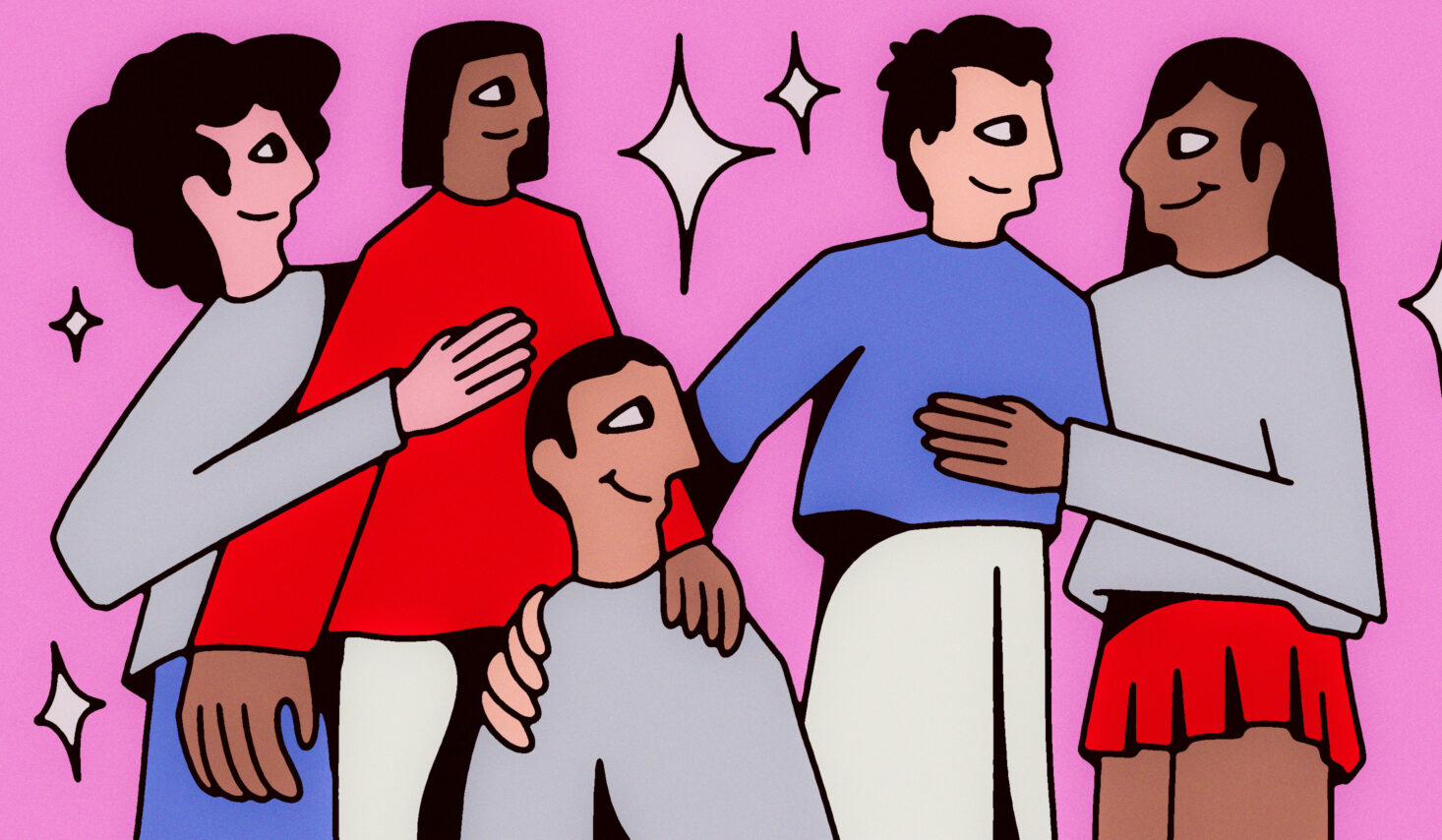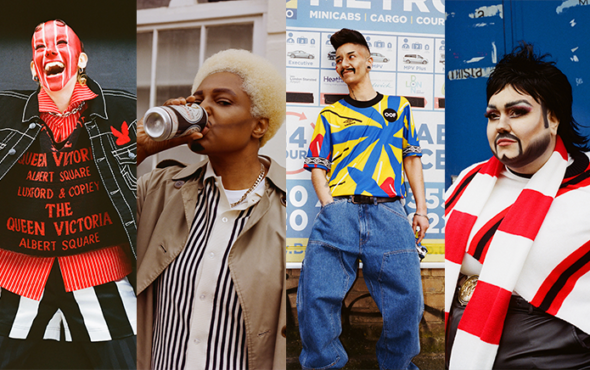
More people than ever are experimenting with non-monogamy and seeing if it works for them, yet practical advice about how to open up your relationship – and how to proceed once you’ve done it – can be hard to find.
While the immediate instinct following your newfound sexual freedom might be to find the best dating app for non-monogamous folks and get swiping, there’s actually a lot more to figure out. Luckily, we’ve called in the experts.
What is an open relationship?
An open relationship can refer to a number of relationship styles, wherein people are free to date, have sex, and/or form romantic relationships with multiple people. Open relationships fall under the umbrella of non-monogamy, though don’t necessarily all look the same.
Dr Liz Powell, a licensed psychologist specialising in non-traditional relationships and author of Building Open Relationships, explains that the majority of us approach dating with a relationship style “based in ownership and control and entitlement and assumptions.” Open relationships challenge these ideas, encouraging us to build relationships based on “clear communication and empowerment and autonomy and agency.”
There are lots of terms you might come across in the process of opening up your relationship. Here are a few key ones to get you started:
- Monogamy: having a romantic and/or sexual relationship with just one person at any time.
- Non-monogamy (also known as ‘ethical non-monogamy’ or ENM, or ‘consensual non-monogamy’ or CNM): having the potential to date or have romantic and/or sexual relationships with more than one person at any time, with the knowledge of everyone involved.
- Polyamory: a form of non-monogamy with emphasis on having the freedom to form intimate connections with multiple partners.
- Hierarchical polyamory: a form of polyamory where the couple are considered the ‘primary relationship’ and additional romantic and/or sexual relationships they form are ‘secondary’.
- Open relationship: a form of non-monogamous relationship where you and your partner or partners are free to date or form romantic and/or sexual connections with new people.
- Metamour: a partner of one of your partners.
- Compersion: the joy you can feel for your partner’s happiness with or excitement about another partner or relationship.
With many of these terms, exact definitions differ so it’s important to understand that fluidity is part of the equation. For example, there is no precise moment where an open relationship becomes a polyamorous one – feelings, and situations, can change and commitments can escalate.
Expectations also vary from person to person: two individuals doing non-monogamy might have relationships and boundaries within those relationships that look completely different. Unlike in the monogamous world, where there is more of a consensus around certain milestones or models of behaviour, there is no “right” way to open up your relationship.
That said, communication and clearly stating what you want and being as transparent as possible – even when it’s scary, and even when you feel like you’re stating the obvious – are key whenever it comes to non-monogamy.
Myths about open relationships
While there is an increased awareness of non-monogamy, mainstream media depictions of open relationships rarely reflect the reality of what those relationships can look like. As Dr Powell points out, it’s not all sex parties and orgies – the reality is that non-monogamous folks are “spending a lot of time on Google Calendar and a lot of time processing.”
Open relations involve a lot less threesomes than you might imagine and a lot more scheduling. In fact, Keely, who is 27 and non-monogamous, says that it’s a lot more boring than people make it out to be – but in a good way! Dr Powell explains that if you don’t want to talk about your feelings a lot, you might not be suited to an open relationship. “Non-monogamy is just a ton of talking about your feelings. You will talk about your feelings endlessly, because you’re going to have so many people with whom you’ll need to talk about your feelings.”
Talking of feelings, there is also a misconception that people who do non-monogamy don’t experience jealousy. Sarah (who is 34 and polyamorous) says that unpicking the ways we have been socialised to think about love, sex and relationships doesn’t “magically make every anxious or jealous feeling disappear, but it will give you tools to deal with them.” Indeed, experiencing those emotions does not mean you are ‘failing’ at an open relationship – Sarah says that hard feelings are “normal and valid.”
Opening your relationship may bring connections you are not expecting. Jo, who is 44 and describes her relationship style as slightly hierarchical, has found her community through polyamory. Not only that, but your relationships do not have to be equal, or treated equally – just fairly. As Jo discovered: “Each of my partners brings something very different to my life, and my role in each of their lives is unique.”
“Non-monogamy isn’t a plaster you can stick over issues in your relationship, it’s an entirely new relationship that requires work and care”
Negotiating an open relationship
While talking to your partner is essential for both monogamous and open relationships, ‘communicate!’ is advice that is easy to give and much harder to actually do. Where do you even start with negotiating an open relationship? Often, the process of deciding to be non-monogamous with a partner isn’t the most difficult bit – it’s defining what your new relationship will look like and ensuring that all parties have a common understanding of the types of assurances and freedoms they will need in order to make it worthwhile.
An exercise Dr Powell recommends to couples who want to open their relationship is to “take everything about your relationship, lay it out and decide what you actually want.” This can be a process of writing down – on paper or on your Notes app – the practices, standards and fun couple activities that will ensure you will feel safe to explore. Powell advises couples to do this separately, so people don’t just make choices based on what they think their partner wants. In an exercise like this, it’s important to check in with yourself and be honest about what you want.
For Sarah and her nesting partner, their first step was to discuss what they needed, wanted, and didn’t want. “We discussed safer sex practices, scheduling of dates versus time for us as a couple, what we thought we would want to hear or not hear about the other’s relationships.”
It’s important to schedule in solo time as well, rather than keeping your schedule jam-packed with time with a partner or out dating. Powell says that due to how pervasive mononormativity (the presumed social default of monogamy) is, couples often have an assumption that “any time that their partner does not have other plans is automatically time that they are entitled to or that their partner will want to spend with them.”
Powell advises couples to plan for what they will do if their partner has a date and they don’t have plans. “There’s this tendency to try to have something fun scheduled whenever your partner has a date, but if one person’s thing falls through, the other person still has to figure out how to deal with it.”
Breaking up to build new relationships
When opening up your relationship, Powell says it can be helpful to think of it “as though your previous relationship is ending, you’re breaking up, and you are starting an entirely new relationship with non-monogamy at its core.” This allows you to start from scratch, and decide what you want your relationship to look like, rather than what the traditional relationship escalator says it “should” look like.
One of the biggest mistakes couples can make when opening their relationship is simply not unpacking mononormativity. Jo thinks it is important not to get “bogged down in the minutia of ‘rules’, but make sure you understand what ‘opening up’ looks like to each of you.”
Keely and their partner initially drew up rules that they would both to follow if either of them saw another person, but they found that “the first few times my partner saw new people, we found that the initial rules we’d outlined for interactions were not realistic, and we had to reassess how to make the arrangements feel okay to everyone.”
And while the idea of your partner developing feelings for someone else is also scary, Powell thinks that making rules about having sex but not being allowed to have feelings rarely works in reality. “As humans don’t tend to be particularly great at being able to not develop feelings for someone with whom we have a close connection.”
Emotional risks and vulnerability
Increased risk of STI transmission often comes up when discussing the challenges of non-monogamy. However, research in 2015 found that while having an increased number of sexual partners increases the potential for STI transmission, people engaged in non-monogamy were more likely to use condoms during sex and more likely to get tested for STIs regularly, so the risk level wasn’t found to be greater.
Additionally, Powell believes that anxiety about STI risk is often misplaced. “The majority of the time when people say that what they’re upset about is STI risk, what they’re actually upset about is emotional risk.” They believe that people tend to move towards not using barriers with partners because we care about them, not because they have great safer sex practices. It’s important to own our fears related to intimacy and emotional connection.
For Cay and her partner, their biggest challenge was needing to accept that while they care deeply about each other, they each had needs that were not being met and could not be met by the other. “It’s incredibly difficult to accept one’s own shortcomings, but it is instrumental in understanding any form of non-monogamy.”
You shouldn’t let the potential challenges of non-monogamy put you off opening up your relationships. In fact, Powell believes that focussing on your fears when negotiating the boundaries of your new relationship can “drive you to make a lot of decisions and agree to a lot of things that you then are not going to feel good about.”
And that is the aim: to build a relationship you feel good about. Non-monogamy isn’t a plaster you can stick over issues in your relationship, it’s an entirely new relationship that requires work and care. It might not be easy, but it can be incredibly rewarding to create a relationship that works for you and your partner – or indeed your partners.



